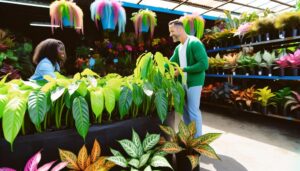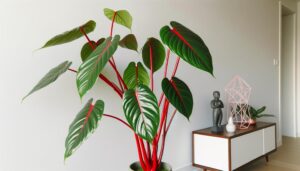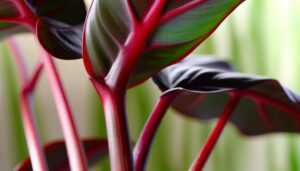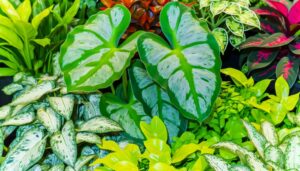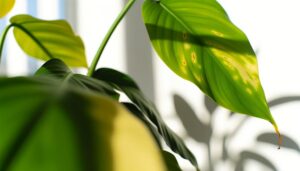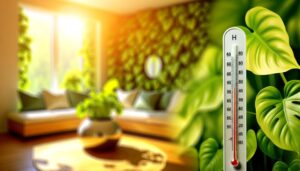What Are the Characteristics of Philodendron Erubescens 'Dark Lord'?
Philodendron Erubescens 'Dark Lord' is a captivating plant originating from Colombia. It features heart-shaped leaves that showcase dramatic color variations from deep burgundy to nearly black, attributed to high anthocyanin content.
The glossy, dark-green to black upper surfaces contrast with the reddish undersides. This species exhibits a vigorous climbing habit, utilizing aerial roots for support and nutrient uptake.
It thrives in bright, indirect light, well-aerated soil, and high humidity, making it perfect for vertical gardening. Maintaining temperatures between 65°F to 80°F and using balanced fertilizers promote optimal growth.
Exploring more will reveal its impressive adaptability and care requirements.
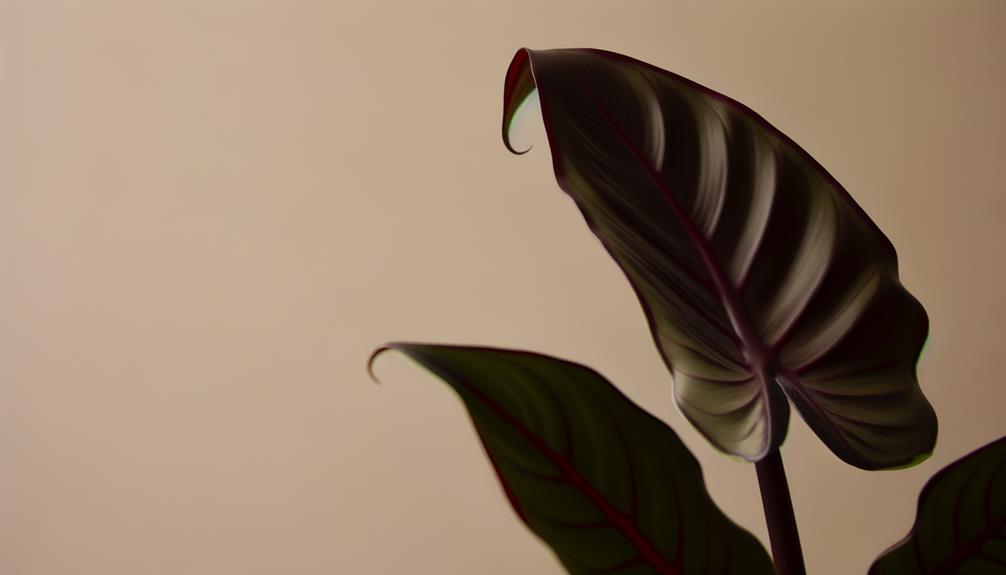
Key Takeaways
- Originates from Colombia and thrives in humid, shaded environments.
- Leaves are heart-shaped, up to 45 cm long, with deep burgundy to almost black coloration.
- Grows vigorously with a climbing habit supported by aerial roots.
- Requires bright, indirect light and well-aerated, nutrient-rich soil.
- Prefers temperatures between 65°F to 80°F and humidity levels between 60% and 80%.
Origin and Background

Philodendron erubescens 'Dark Lord,' a striking cultivar of the Araceae family, originates from the tropical rainforests of South America, specifically Colombia.
This perennial climber thrives in its native humid, shaded environments, where it benefits from the rich, organic matter of forest floors. The plant is characterized by its robust, vining habit, which enables it to climb trees and other structures.
It exhibits a remarkable adaptability to both terrestrial and epiphytic growth forms. Philodendron erubescens 'Dark Lord' possesses aerial roots, essential for nutrient uptake and anchoring. Its stems are thick and sturdy, supporting its extensive foliage.
This cultivar's unique morphological attributes underscore its evolutionary adaptation to the dense, competitive ecosystems of its origin, contributing to its popularity among horticulturists.
Leaf Coloration
One of the most enchanting features of Philodendron erubescens 'Dark Lord' is its dramatic leaf coloration, which ranges from deep burgundy to almost black, adding a visually striking element to any collection.
The leaves emerge with a rich, dark red hue and gradually shift to a deep brown-black as they mature. This extraordinary pigmentation is a result of high concentrations of anthocyanins, which are pigment molecules responsible for the red, purple, and blue hues in plants.
The leaf's upper surface often exhibits a glossy texture, enhancing its vibrant color and giving it a visually appealing sheen. This unique coloration not only serves aesthetic purposes but also aids in the plant's adaptation to its natural environment by providing UV protection.
Leaf Shape and Size
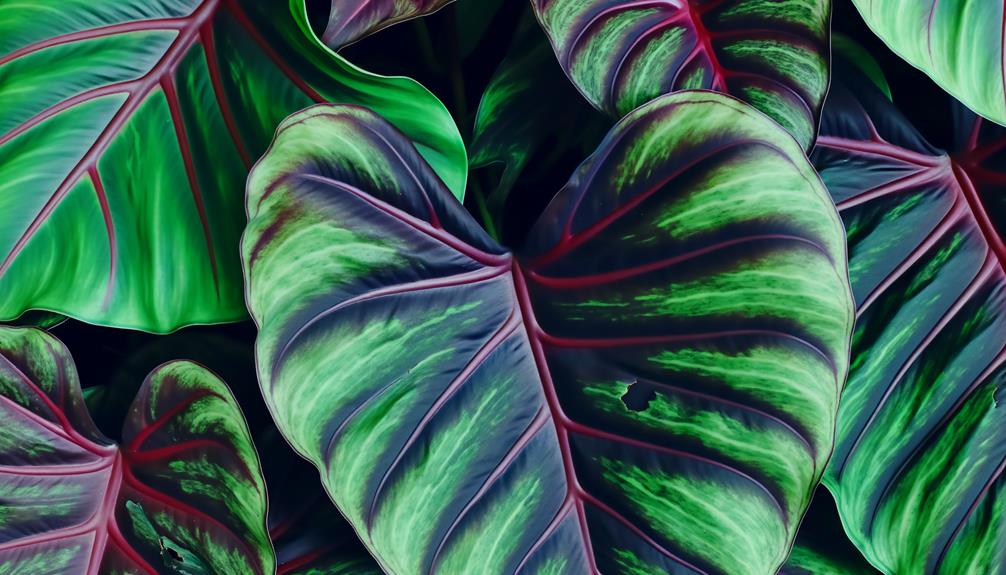
Philodendron erubescens 'Dark Lord' exhibits a distinct heart-shaped leaf structure, characteristic of its species. The leaves can reach dimensions of up to 45 centimeters in length and 30 centimeters in width under ideal growth conditions.
This substantial leaf size contributes to the plant's dramatic visual appeal and its effectiveness in indoor ornamental applications.
Heart-shaped Leaf Structure
The leaves of Philodendron erubescens 'Dark Lord' showcase a distinct heart-shaped form, characterized by their wide, lobed base and narrowing apex. This unique shape is not just visually pleasing but also functionally important, aiding in efficient photosynthesis and water drainage. The upper surface of the leaf typically appears as a deep, dark green to nearly black, while the lower surface may exhibit a reddish tint, enhancing its decorative charm. The sturdy petioles, supporting the leaves aloft, ensure ideal light exposure.
| Characteristic | Description | Importance |
|---|---|---|
| Form | Heart-shaped | Visual and practical |
| Base | Wide and lobed | Improves water flow |
| Apex | Narrowing | Sleek appearance |
| Upper Surface Color | Dark green to black | Visual attractiveness |
| Lower Surface Color | Reddish | Decorative interest |
This structure highlights the plant's adaptive tactics in its original habitat.
Leaf Dimensions and Growth
Building on the heart-shaped anatomy, the leaves of *Philodendron erubescens* 'Dark Lord' exhibit considerable variation in size, often reaching lengths of up to 18 inches and widths of approximately 12 inches, depending on environmental conditions and plant maturity.
These dimensions are influenced by factors such as light exposure, humidity, and nutrient availability. The leaves are typically dark green to nearly black with a glossy surface, and their large size enhances the plant's dramatic appearance.
As the plant matures, the leaves develop a more pronounced pointed tip and prominent venation, contributing to its distinctive aesthetic. The robust growth pattern of *P. erubescens* 'Dark Lord' makes it a striking focal point in both indoor and outdoor botanical settings.
Growth Habit
The Philodendron erubescens 'Dark Lord' exhibits a vigorous climbing growth pattern, utilizing aerial roots to anchor itself to various supports. This species produces large, elongated, heart-shaped leaves that can reach up to 45 centimeters in length.
The combination of its climbing habit and substantial foliage makes it an impressive specimen in both natural habitats and cultivated environments.
Climbing Growth Pattern
Philodendron erubescens 'Dark Lord' displays a vigorous climbing growth pattern, utilizing aerial roots to anchor and ascend vertical surfaces. These specialized roots emerge from the plant's nodes, enabling it to secure itself effectively to tree trunks, trellises, or other support structures.
The species demonstrates hemiepiphytic behavior, meaning it can grow both terrestrially and epiphytically. Its robust climbing ability allows it to reach considerable heights, often exceeding several meters in ideal conditions. The plant's natural habitat in tropical rainforests supports this climbing tendency, where it competes for sunlight by scaling the forest canopy.
This characteristic makes P. erubescens 'Dark Lord' perfect for vertical gardening applications, adding dynamic visual interest to both indoor and outdoor spaces.
Leaf Size and Shape
Characterized by large, heart-shaped leaves that can exceed 18 inches in length, Philodendron erubescens 'Dark Lord' displays a dramatic foliage presence.
The leaves are remarkably broad, often spanning over 12 inches in width, creating an imposing visual effect.
Emerging with a deep, reddish-bronze hue, the leaves mature to a dark, glossy green, sometimes nearly black, providing a striking contrast.
The petioles, which are sturdy and elongated, support the expansive leaf blades, enhancing the plant's overall structural integrity.
This species features a pinnate venation pattern, ensuring efficient nutrient transport and ideal photosynthesis.
Its luxuriant foliage not only contributes to its aesthetic appeal but also signifies its vigorous growth habit, making it a captivating specimen for indoor and outdoor cultivation.
Light Requirements
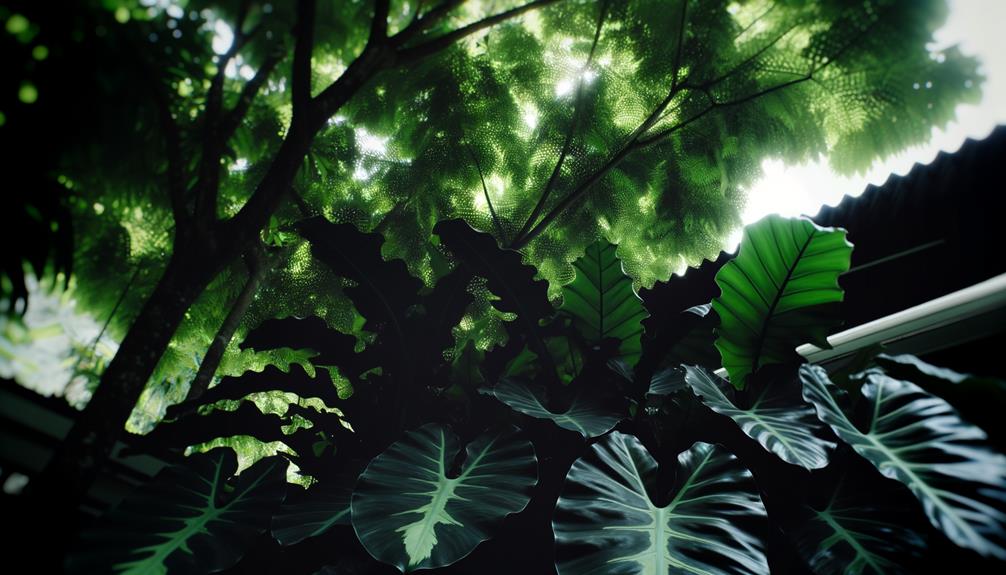
Optimal growth of Philodendron erubescens 'Dark Lord' necessitates bright, indirect light to replicate its natural habitat. Hailing from the understory of tropical rainforests, this species flourishes in environments where sunlight is filtered through the canopy, preventing direct exposure.
Prolonged direct sunlight can lead to leaf scorching, characterized by browning and wilting. Conversely, insufficient light will result in leggy growth and diminished leaf pigmentation, compromising the plant's stunning visual appeal.
Artificial lighting, such as fluorescent or LED grow lights, can supplement natural light, especially in indoor settings. It is essential to maintain a consistent light source, as fluctuations can stress the plant, affecting its overall health and growth. Regularly rotating the plant ensures even light distribution, promoting symmetrical development.
Watering Needs
Philodendron erubescens 'Dark Lord' thrives in consistently moist, well-draining soil, necessitating careful attention to its watering regimen.
It is essential to maintain ideal moisture levels without saturating the soil, as excessive water can lead to root rot and other fungal issues.
Understanding the balance between adequate hydration and overwatering is vital to ensuring the plant's peak health and growth.
Ideal Moisture Levels
Maintaining the most suitable moisture levels for Philodendron erubescens 'Dark Lord' requires a careful balance between consistent hydration and preventing waterlogged soil conditions.
This tropical species thrives in well-draining soil that retains some moisture but does not become saturated. Ideal watering practices involve allowing the top inch of the soil to dry out before the next watering session.
Employing a soil mixture containing components like perlite, orchid bark, and peat moss can enhance moisture retention while ensuring proper drainage. Additionally, using a pot with drainage holes helps prevent excess water accumulation, thus safeguarding the plant's root system.
Monitoring the ambient humidity, ideally between 60-80%, further contributes to maintaining the appropriate moisture levels necessary for the plant's health and optimal growth.
Overwatering Risks
Excessive watering can lead to root rot and other harmful conditions for Philodendron erubescens 'Dark Lord', requiring careful management of its hydration needs. Root rot, caused by waterlogged soil, hinders the plant's ability to absorb nutrients, resulting in yellowing leaves and stunted growth.
Ensuring well-draining soil is crucial to prevent water accumulation around the roots. Overwatering can also trigger fungal infections like Pythium and Phytophthora, further compromising plant health. Monitoring soil moisture levels, preferably allowing the top inch to dry out between watering, can mitigate these risks.
Using a pot with drainage holes and avoiding waterlogged saucers are additional preventive measures. Proper watering practices are essential for maintaining the strong health and aesthetic appeal of this exotic species.
Soil Preferences
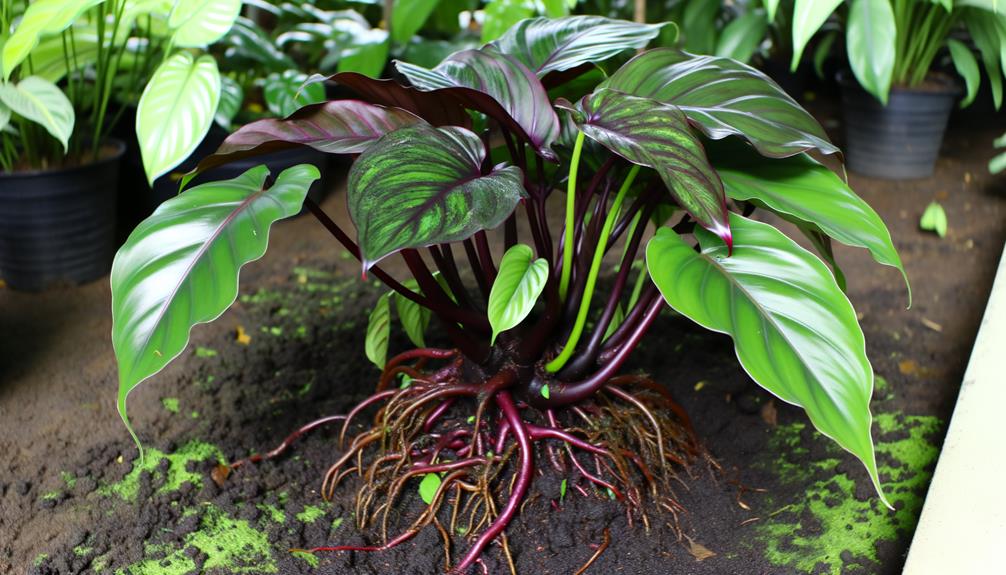
For the finest growth, Philodendron erubescens 'Dark Lord' requires well-aerated, nutrient-rich soil with excellent drainage properties. A potting mix tailored for aroids, typically comprising a blend of peat moss, perlite, and orchid bark, ideally supports this species.
The peat moss retains moisture while providing organic nutrients, and the perlite enhances aeration and drainage. Orchid bark contributes to the structural integrity of the soil, preventing compaction and ensuring root breathability. Additionally, incorporating compost or worm castings can further enrich the substrate, promoting robust growth and vibrant foliage.
Adequate drainage is paramount to prevent root rot, so containers with drainage holes are essential. By adhering to these soil preferences, one can cultivate a healthy and thriving Philodendron erubescens 'Dark Lord'.
Temperature Tolerance
Philodendron erubescens 'Dark Lord' flourishes in temperatures ranging from 65°F to 80°F (18°C to 27°C), reflecting its native tropical environment. Maintaining this temperature range is essential for prime growth and health. Exposure to temperatures outside this range can lead to stress and impede the plant's development. Cold drafts or sudden temperature fluctuations should be avoided to prevent damage.
To guarantee the best conditions, consider the following:
- Avoid temperatures below 55°F (13°C): Prolonged exposure can cause leaf discoloration and stunted growth.
- Shield from extreme heat above 85°F (29°C): Excessive heat can cause wilting and leaf burn.
- Sustain consistent temperatures: Sudden changes can disrupt physiological processes and impact overall plant vitality.
Adhering to these guidelines will help sustain the Philodendron erubescens 'Dark Lord'.
Humidity Levels
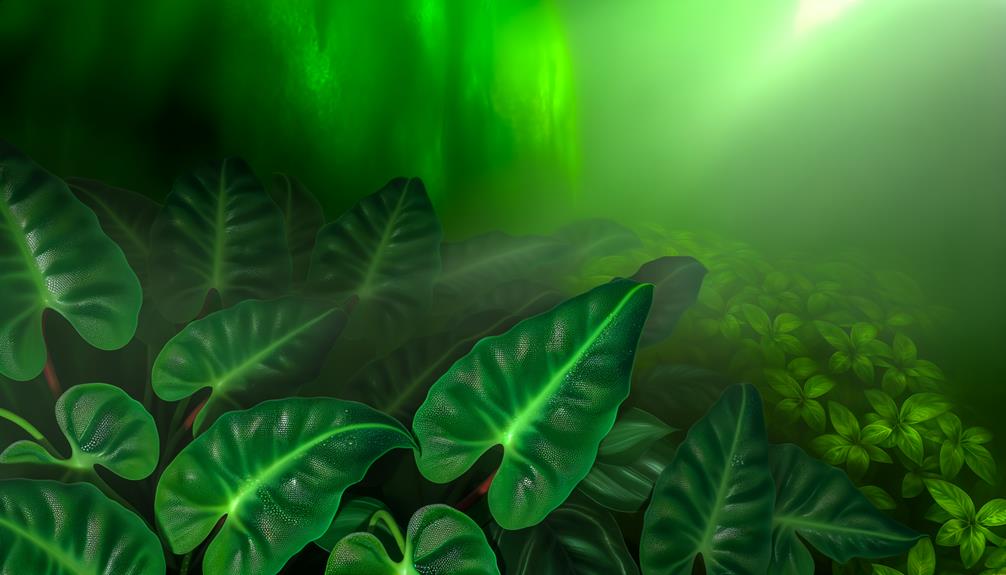
Maintaining appropriate moisture levels is equally crucial for the ideal growth of Philodendron erubescens 'Dark Lord'.
This tropical plant thrives in environments with humidity levels between 60% and 80%. Inadequate moisture can lead to leaf browning and reduced growth, compromising its striking appearance.
To achieve these conditions, consider using a humidifier or placing the plant on a pebble tray with water. Additionally, misting the foliage can help replicate its natural habitat, although it should be done with caution to prevent fungal infections.
Regular monitoring with a hygrometer ensures peak moisture levels, enhancing the plant's health and vigor. Proper moisture management fosters lush, vibrant leaves, aligning with the plant's innate requirements.
Fertilization Tips
To enhance the growth and health of Philodendron erubescens 'Dark Lord,' it is essential to implement a targeted fertilization regimen. Employing a balanced, water-soluble fertilizer with an N-P-K ratio of around 20-20-20 can significantly boost the plant's vigor. Fertilization should be carried out during the active growing season from spring to early autumn.
Key fertilization tips include:
- Frequency: Apply fertilizer every 4-6 weeks to maintain consistent nutrient availability.
- Dilution: Dilute the fertilizer to half the recommended strength to prevent root burn.
- Observation: Monitor the foliage for signs of excessive fertilization, such as yellowing leaves or salt buildup on the soil surface.
Implementing these practices will help promote strong growth and colorful foliage in Philodendron erubescens 'Dark Lord.'
Common Pests and Diseases
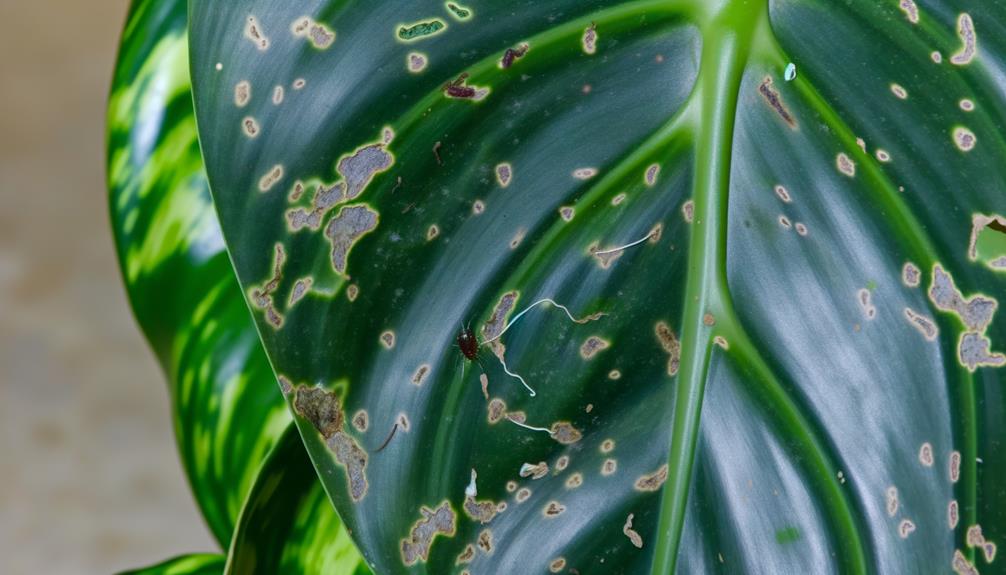
A variety of pests and diseases can afflict Philodendron erubescens 'Dark Lord,' including common issues such as spider mites (Tetranychus urticae), aphids (Aphidoidea), and bacterial leaf spot caused by Xanthomonas campestris.
Spider mites puncture plant cells to feed, resulting in stippled, discolored leaves and fine webbing. Aphids excrete honeydew, encouraging sooty mold growth and leaf distortion. Bacterial leaf spot manifests as water-soaked lesions that eventually turn brown or black, causing significant foliar damage.
Effective management includes regular inspection, maintaining proper humidity, and using appropriate insecticides or bactericides. Quarantine new plants and promote good air circulation to minimize the risk of infestation and infection. Early detection is essential for maintaining plant health.
Conclusion
Philodendron erubescens 'Dark Lord' epitomizes an extraordinary specimen in the plant world, showcasing unique attributes such as its dark, lustrous foliage and robust growth habit.
Adaptable to diverse environmental conditions, this plant thrives with proper light, temperature, and humidity levels. However, vigilance against pests and diseases is paramount.
As the adage goes, 'An ounce of prevention is worth a pound of cure,' underscoring the importance of proactive care in maintaining this alluring cultivar's health and essentiality.

